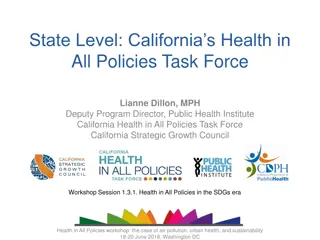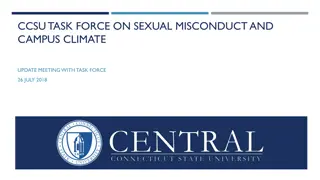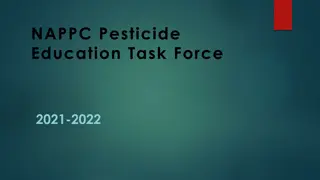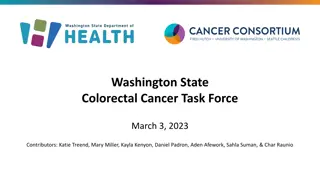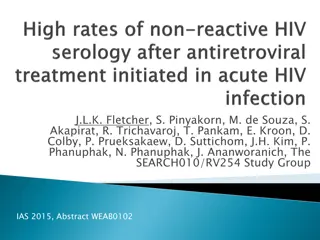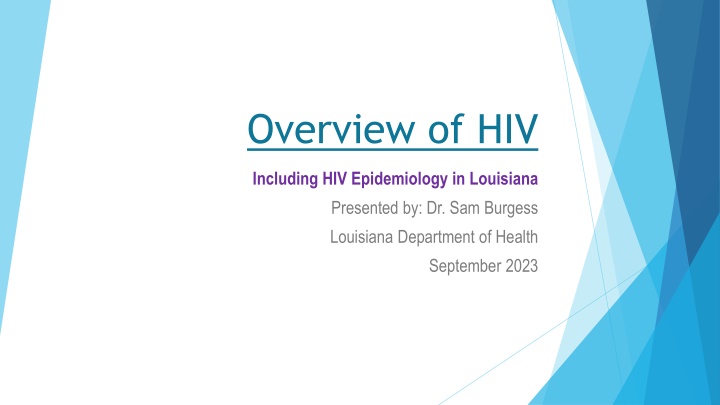
HIV: Overview, Transmission, and Prevention in Louisiana
Explore the basics of HIV, including its definition, transmission routes, estimated risks, and preventive measures like PrEP and PEP. Delve into HIV epidemiology in Louisiana as presented by Dr. Sam Burgess from the Louisiana Department of Health in September 2023.
Download Presentation

Please find below an Image/Link to download the presentation.
The content on the website is provided AS IS for your information and personal use only. It may not be sold, licensed, or shared on other websites without obtaining consent from the author. If you encounter any issues during the download, it is possible that the publisher has removed the file from their server.
You are allowed to download the files provided on this website for personal or commercial use, subject to the condition that they are used lawfully. All files are the property of their respective owners.
The content on the website is provided AS IS for your information and personal use only. It may not be sold, licensed, or shared on other websites without obtaining consent from the author.
E N D
Presentation Transcript
Overview of HIV Including HIV Epidemiology in Louisiana Presented by: Dr. Sam Burgess Louisiana Department of Health September 2023
What is HIV? HIV Human Immunodeficency Virus H: stands for human. It s transferred from human to human contact only. I: stands for immunodeficiency. This means that our immune system is not working as well as it should. V: stands for virus. This is a particular virus that targets and fights our white blood cells. AIDS Acquired Immune Deficiency Syndrome AIDS is a syndrome. Patients do not die from HIV or AIDS, but from opportunistic infections, commonly Tuberculosis or pneumonia. As the body loses white blood cells it becomes harder for our body to fight infection & disease.
The 4 Fluids that Transmit HIV BLOOD SEMEN VAGINAL FLUID BREAST MILK 1. 2. 3. 4.
Estimated Per-Act Probability of Acquiring HIV (when source of exposure has HIV) Type of Exposure Exposure Through Needles: Blood Transfusion Needle-Sharing During Injection Drug Use Percutaneous (Needle-Stick) Sexual Exposures: Receptive Anal Intercourse Insertive Anal Intercourse Receptive Penile-Vaginal Intercourse Insertive Penile-Vaginal Intercourse Receptive Oral Intercourse Insertive Oral Intercourse Risk per 10,000 Exposures 9,250 63 23 (1 out of 435 exposures) (1 out of 159 exposures) 138 (1 out of 73 exposures) 11 (1 out of 909) 8 (1 out of 1,250) 4 (1 out of 2,500) Low Low Source: https://www.cdc.gov/hiv/risk/estimates/riskbehaviors.html
Pre-ExposureProphylaxis (PrEP) PrEP is a medication that utilizes ARVs to prevent HIV infection in people who are not living with HIV. When a person taking PrEP is exposed to HIV, the medication blocks the virus from making copies of itself and prevents them from becoming infected. PrEP does not protect against other STIs or pregnancy. PrEP can reduce the risk of getting HIV by as much as 99%
Post-Exposure Prophylaxis (PEP) PEP involves taking anti-HIV drugs within 72 hours after a potential exposure to HIV. 1-2 pills per day for 28 days. When should someone take PEP? Workplace sharps exposure After sexual assault Unprotected sex Needle sharing PEP should only be used in emergency situations. It is not a substitute for PrEP or other risk reduction methods.
Undetectable=Untransmittable When a person undergoing HIV treatment reaches viral suppression, their viral load (amount of HIV in the body) becomes very low and is considered undetectable. U=U or UNDETECTABLE = UNTRANSMITTABLE SDOH : Access to healthcare, housing and other environmental factors impact a person s ability to remain engaged in HIV medical care to achieve/maintain viral suppression.
Late Testers among People Newly Diagnosed with HIV Louisiana, 2013-2022 Late tester defined a person meeting the AIDS case definition within 30 days of initial HIV diagnosis.
In Louisiana, only 84.4% of persons living with HIV are aware of their diagnosis (~4000 people living with undiagnosed HIV in Louisiana).
Number of People Newly Diagnosed with HIV Louisiana, 2013-2022 COVID -19
People Newly Diagnosed with HIV By Public Health Region, 2022 No. % 100% 24% 19% 5% 10% 5% 6% 14% 8% 7% Rate Louisiana 1-New Orleans 2-Baton Rouge 3-Houma 4-Lafayette 5-Lake Charles 6-Alexandria 7-Shreveport 8-Monroe 9-Hammond/Slidell 858 207 167 46 90 42 55 121 67 63 18.6 23.6 24.0 11.8 15.2 13.9 18.7 23.3 19.3 10.4 *Rate per 100,000
People Newly Diagnosed with HIV by Race/Gender/Risk Louisiana, 2022 Subgroups <9 not shown. GBM: Gay, bisexual, & other men who have sex with men. HRH: High risk heterosexual. PWID: Person who inject drugs.
Linkage to Care among People Newly Diagnosed with HIV Louisiana, 2013-2022 Linkage to care defined as the first CD4 or viral load lab collected on or after date of HIV diagnosis.
Linkage to Care among People Newly Diagnosed with HIV By Public Health Region, 2022 Total No. Diagnoses 858 207 167 46 90 42 55 121 67 63 % Linked within 7 Days 44% 46% 50% 30% 46% 43% 36% 44% 40% 44% % Linked within 30 Days 73% 78% 80% 63% 73% 74% 67% 60% 75% 75% Louisiana 1-New Orleans 2-Baton Rouge 3-Houma 4-Lafayette 5-Lake Charles 6-Alexandria 7-Shreveport 8-Monroe 9-Hammond/Slidell Linkage to care defined as the first CD4 or viral load lab collected on or after date of HIV diagnosis.
Viral Suppression (VS) among People Living with HIV Louisiana, 2013-2022 Viral suppression is a count < 200 copies/mL. In HIV care is defined as having at least one CD4 or viral load during the measurement year.
Viral Suppression (VS) among People Living with HIV By Public Health Region, 2022 % VS among All PLWH 68% 68% 74% 70% 70% 59% 63% 57% 62% 71% % VS among PLWH in Care 88% 88% 88% 89% 89% 86% 88% 82% 84% 90% Louisiana 1-New Orleans 2-Baton Rouge 3-Houma 4-Lafayette 5-Lake Charles 6-Alexandria 7-Shreveport 8-Monroe 9-Hammond/Slidell Viral suppression is a count < 200 copies/mL. In HIV care is defined as having at least one CD4 or viral load during the measurement year.
HIV/STI/Hepatitis Data Resources https://www.louisianahealthhub.org/data-reporting/
Acknowledgments Thank you to the following staff for developing this presentation: Lauren Ostrenga & Jessica Fridge (SHHP Surveillance Supervisor and Manager) Kelley Anderson (SHHP Capacity Building Supervisor)






